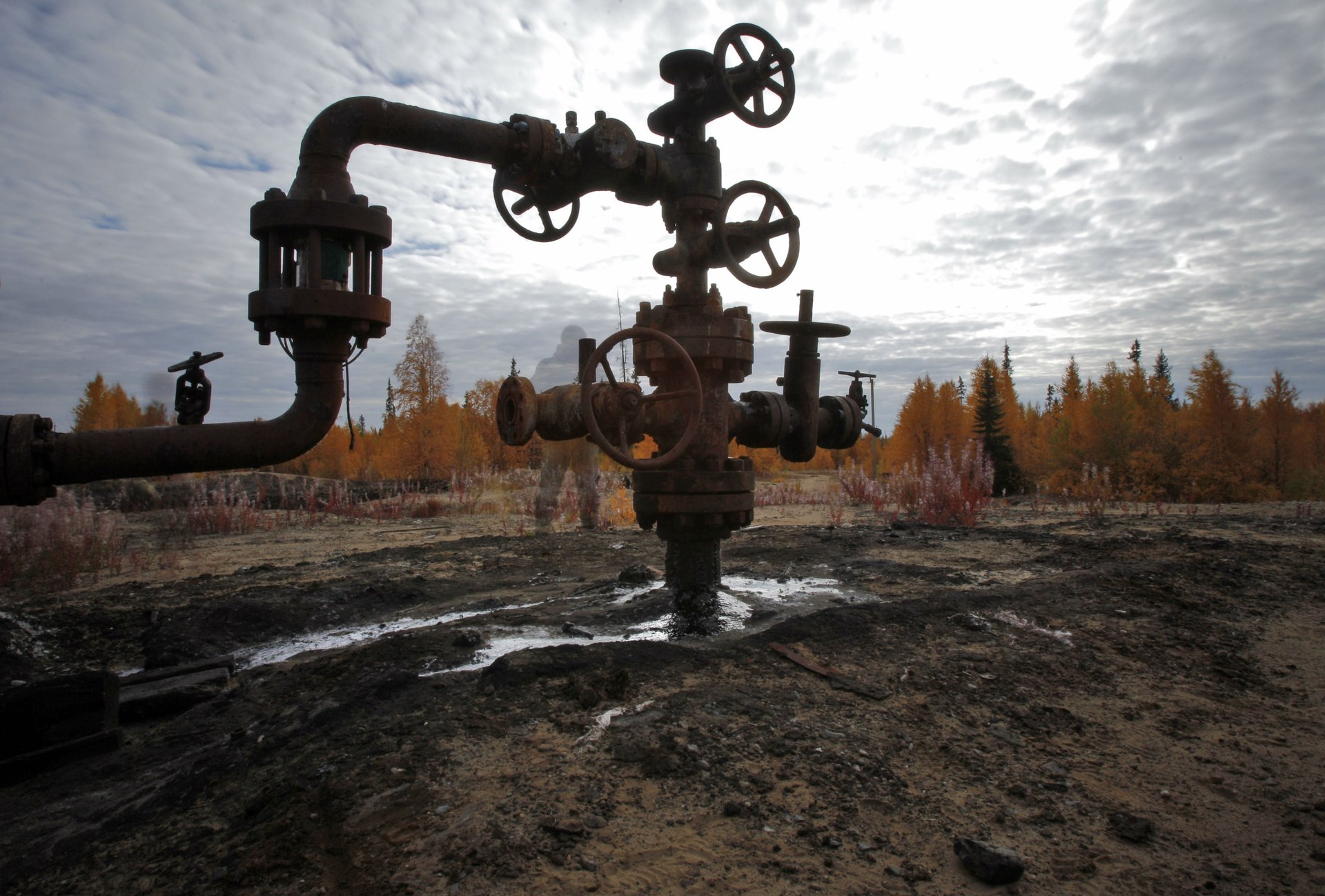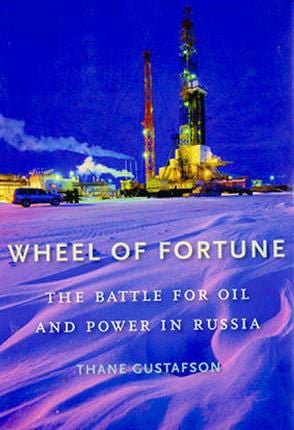Good days for Russia’s newest oil generals, bad days for Russia
Thane Gustafson, a Georgetown University professor of former Soviet studies, offers what is likely to be the definitive account of these eventful years in a rich history drawing from both independent sources and first-hand experiences. General readers may initially balk at Gustafson’s penchant for detail, but the book is worth sticking with as it tracks long-forgotten but important events and personalities over the past two decades. Following the book’s themes forward, Gustafson offers grim conclusions about where Russia’s continued reliance on oil is taking the country.Russia’s political evolution has long been linked to oil. In the waning days of the Soviet Union, regional titans who we can call “oil generals” wielded power and earned immense fortunes based on the petroleum under their control. But when the country collapsed, they lost their footing, and the oil industry became melded with state power under leader Vladimir Putin.

Thane Gustafson, a Georgetown University professor of former Soviet studies, offers what is likely to be the definitive account of these eventful years in a rich history drawing from both independent sources and first-hand experiences. General readers may initially balk at Gustafson’s penchant for detail, but the book is worth sticking with as it tracks long-forgotten but important events and personalities over the past two decades. Following the book’s themes forward, Gustafson offers grim conclusions about where Russia’s continued reliance on oil is taking the country.Russia’s political evolution has long been linked to oil. In the waning days of the Soviet Union, regional titans who we can call “oil generals” wielded power and earned immense fortunes based on the petroleum under their control. But when the country collapsed, they lost their footing, and the oil industry became melded with state power under leader Vladimir Putin.

For Russian oil enterprises, part of survival in the chaotic post-Soviet transition meant the fleet-footed establishment of unheard-of finance divisions had to manage the flow of cash through a time of price ceilings and government vouchers. Then there was the appearance of foreign oil companies, with their alien corporate styles and organizational cultures, a clash that ultimately produced the preferred institutional form of international cooperation—the joint venture.
Gustafson’s style of institutional analysis subtly connects the dots of all this, using key personalities, legal developments, technical issues, sectoral geography and local agendas to profile the era. Ultimately, private companies far out-performed state-run producers, increasing oil production by two-thirds from 1999 to 2004; state-dominated Rosneft raised its production by a mere quarter. Private companies such as Yukos managed this feat by hiring outside service companies and employing new technologies, while breaking traditional Soviet-era commitments to supporting general social welfare in oil-producing cities.
Under Putin, the industry fell under far greater state control. Rosneft was transformed into a national champion and Yukos was brought to heel. According to Gustafson, even during a boom period for private companies, the Russian state never fully exited the industry, maintaining legal rights in crucial areas such as field development, pipeline ownership, exploration licensing and domestic distribution. They provided the basis through which the Kremlin reasserted itself under Putin.
With so much nuance and careful tracing, the book is striking for one deviation and one general omission. The deviation is an idiosyncratic explanation of the “Yukos affair”—Putin’s dismembering of what was then the country’s largest and most successful company, and the jailing of its brazenly defiant owner, Mikhail Khodorkovsky.
Gustafson explains how Yukos’s relentless drive for higher production alienated long-time oil players who likened Khodorkovsky’s practices to the late Soviet-era desecration of oilfields. Khodorkovsky seemed to deliberately do everything to gall both the Kremlin and his oilfield rivals. He used a sophisticated system of so-called transfer-pricing, sending Yukos cash into special tax zones within and outside of Russia. Khodorkovsky openly bucked the Kremlin in planning an unsanctioned pipeline with CNPC, the Chinese oil company. He lobbied within the Duma for a new tax regime and giving high profile interviews that criticized the Russian state’s capacities and regulatory role.
But after setting the stage, Gustafson quickly dismisses some of the prevailing explanations of the Yukos crackdown, such as renewed state predation, Yukos’s flirtations with Chevron and ExxonMobil, and a Putin emboldened by high oil prices. Instead, Gustafson posits that Khodorkovsky’s brash style, and his willingness to flout Putin’s dictum against businessmen practicing politics, tipped the scales and prompted decisive Kremlin action against the oligarch: “Without the factor of personality, in short, the contest and the privatized oil industry would arguably not have descended into such a bitter confrontation among a small group of men, which in turn served as the convenient instrument for one leadership faction to gain the edge in the making of policy.”
The spotlight on Khodorkovsky’s personality breaks from the book’s otherwise unrelenting focus on the interplay between institutional evolution and political incentives. It seems unnecessarily narrow, given that the Yukos affair is viewed as a key event in Russian political history precisely because it encapsulates so many hallmarks of Putin’s Russia—the Kremlin’s use new authoritarian techniques of control, its resolve to consolidate control over the strategically viewed energy sector, its compulsive attention to public relations and acts of political defiance, and its near obsessive pushback against Western actors allegedly bent on undermining Russian sovereignty.
The international dimension, curiously, also seems to get short shrift in favor of the domestic political economic analysis, although with a book weighing in at over 500 pages, it is difficult to fault the author for the omission. Gustafson provides great detail about the engagement and limitations of foreign companies, including an illuminating account of BP’s travails. But the book does not mention important episodes like the opening of the politically maligned Baku-Tbilisi-Ceyhan pipeline (the first major post-Soviet project to bypass Russian territory); the political impact of Gazprom-pricing disputes with Ukraine and accompanying pipeline closures; the Russia-Georgia War of 2008; or China’s 2009 emergency $25 billion loan package to Rosneft and Transneft.
More broadly, it is difficult to disentangle the domestic side of Russia’s new state energy strategy from its foreign policy towards Europe, its effort to control energy development and transit in the Caucasus and Central Asia, its use of energy discounts as an instrument of Russian-led regional integration, and its complex dealings with China. Gustafson’s insights would be of great interest, as would his assessment of whether the Kremlin has succeeded in wielding energy as a strategic weapon.
In his concluding chapters, Gustafson returns to earlier themes to offer a relatively pessimistic account of the sector’s prospects. Since oil is more than likely central to Russia’s general economic health, the projection is a gloomy one for the country indeed.
It does not get better, Gustafson says. Russian oil companies have concentrated on improving extraction of existing fields through conventional methods, but are ill-prepared and undercapitalized to implement the more costly techniques necessary to recover the peripheral oil that is critical for maintaining production. If Russia wishes to modernize, it must do better on the oil patch while also bucking the oil-curse. Such reforms will reduce the government take of oil income. The outcome? According to Gustafson, another round of conflict for control over the sector.